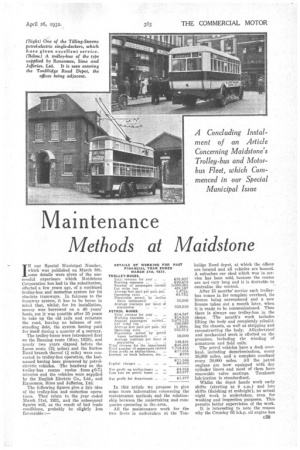Maintenance Methods at Maidstone
Page 61

Page 62

If you've noticed an error in this article please click here to report it so we can fix it.
IN our Special Municipal Number, which was published on March 8th. some details were given of the successful experience which Maidstone Corporation has had in the substitution, effected a few years ago, of a combined trolley-bus and motorbus system for its obsolete tramways. In fairness to the tramway system, it has to be borne in mind that, whilst, for its installation, money was borrowed on a 40 years' basis, yet it was possible after 25 years to take up the old rails and reinstate the road, leaving no balance of outstanding debt, the system having paid for itself during a quarter of a century.
The trolley-buses were introduced first on the Barning route (May, 1928), and nearly two years elapsed before the Loose rout (n miles) and the Sutton Road branch thereof (i mile) were converted to trolley-bus operation, the lastnamed having been pioneered by petrolelectric vehicles. The headway on the trolley-bus mutes varies from (6-7* minutes and the vehicles were supplied by the English Electric Co., Ltd., and Ransomes, Sims and Jefferies, Ltd.
The following figures give a fair idea of the trolley-bus and motorbus operations. They relate to the year ended March 31st, 1931, and the subsequent figures will, as the result of bad trade conditions, probably be slightly less favourable—. bridge Road depot, at which the offices are located and all vehicles are housed. A suburban car shed which was in ,service has been sold, because the routes are not very long and it is desirable to centralize the control.
After 15 months' service each trolleybus comes in for complete overhaul, its licence being surrendered and a new licence taken out a month later, when it is ready to be recommissioned. Thus there is always one trolley-bus in the shops. The month's work includes lifting the body and completely rebuilding the chassis, as well as stripping and reconstructing the body. All electrical and mechanical work is effected on the premises, including the winding of armatures and field coils.
The petrol vehicles have a dock overhaul, including decarbonization, every 10,000 miles, and a complete overhaul every 30,000 miles. AU the petrol engines are now equipped with dry cylinder liners and most of them have renewable valve seatings. Tecalemit harication is standardized.
Whilst the depot hands work early shifts (starting at 4 a.m.) and late shifts (finishing at midnight), no actual night work is undertaken, even for washing and inspection purposes. This permits better supervision of the work.
It is interesting to note the reason why the Crossley 65 b.h.p. oil engine has been chosen for two new vehicles. It is because, for a six-cylindered unit of this power, the engine is sufficiently compact to permit a fairly large single-deck body to be fitted. Incidentally, all bright fittings on the new vehicles will be of Staybrite stainless steel.
A point of interest is the satisfaction that has been obtained with a TillingStevens petrol-electric chassis type T86, employed for tower-wagon work. It is five years old and has bettered previous vehicles, because of its capacity for moving along smoothly at
to permit line inspection. It is quite speedy enough for the corporation requirements and a further advantage is that it accelerates from rest with particular smoothness.
Friendly relations exist with the only important bus company concerned on local routes, i.e., Maidstone and District Motor Services, Ltd. There are no co-ordinated time-tables, but an understanding exists that the company charges a minimum of 4d., against the corporation's maximum fare of 3d. from
the town centre. This protects the trolley-bus service ; as regards the motorbuses no special understanding has been found necessary.
There is not very much in the way of excursion and tour licences from Maidstone, except those held by the Maidstone and District undertaking, and there are practically no privately owned bus services. Long-distance coaches are not allowed to eater for the local traffic, and many are not even allowed to stop at Maidstone.












































































































